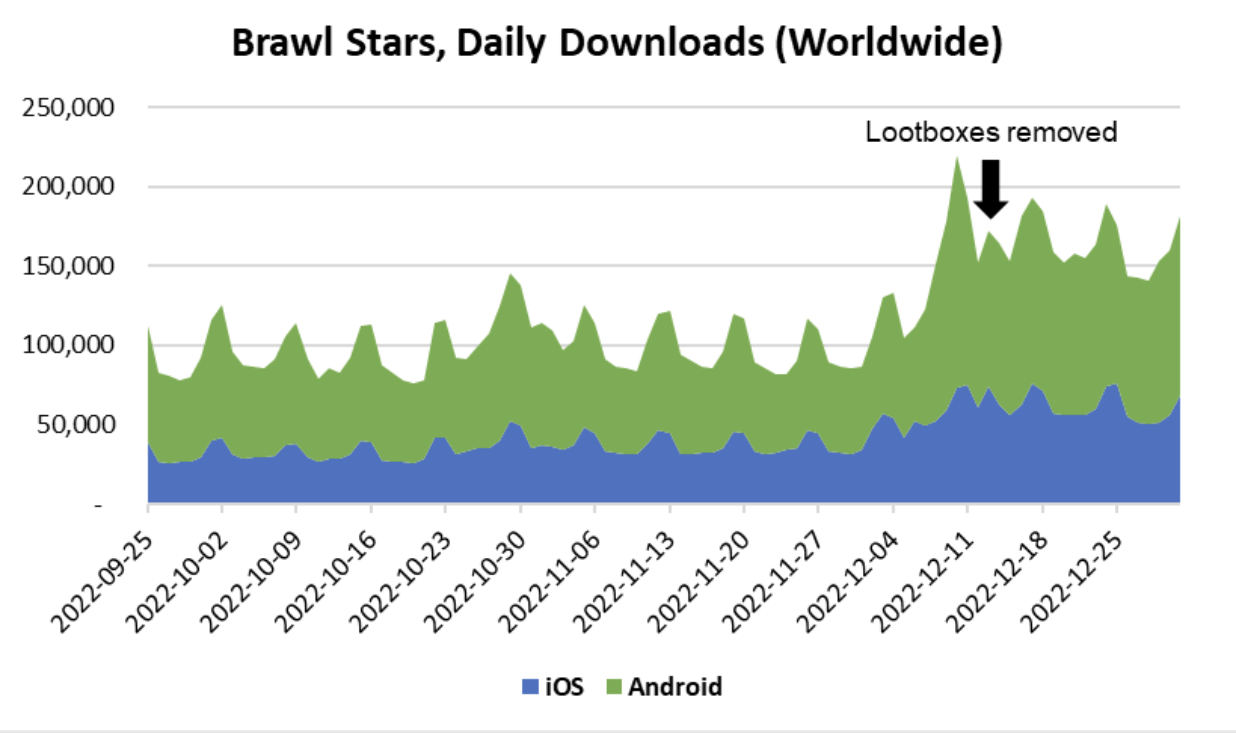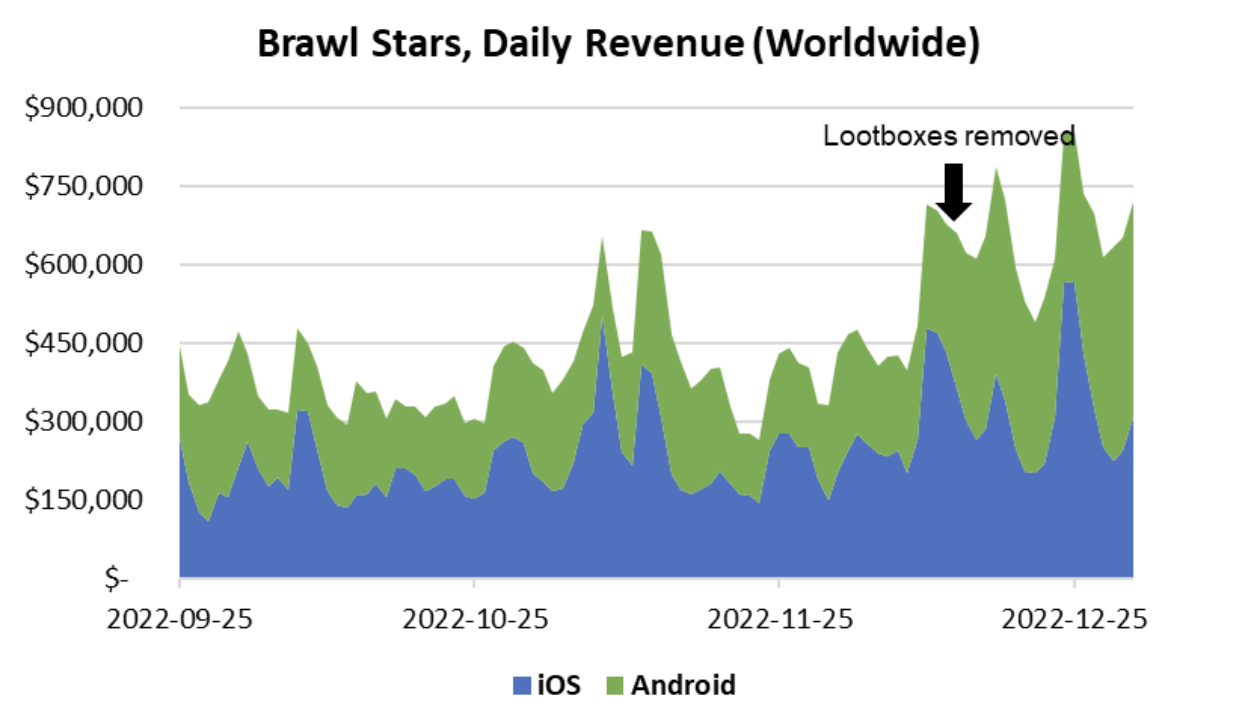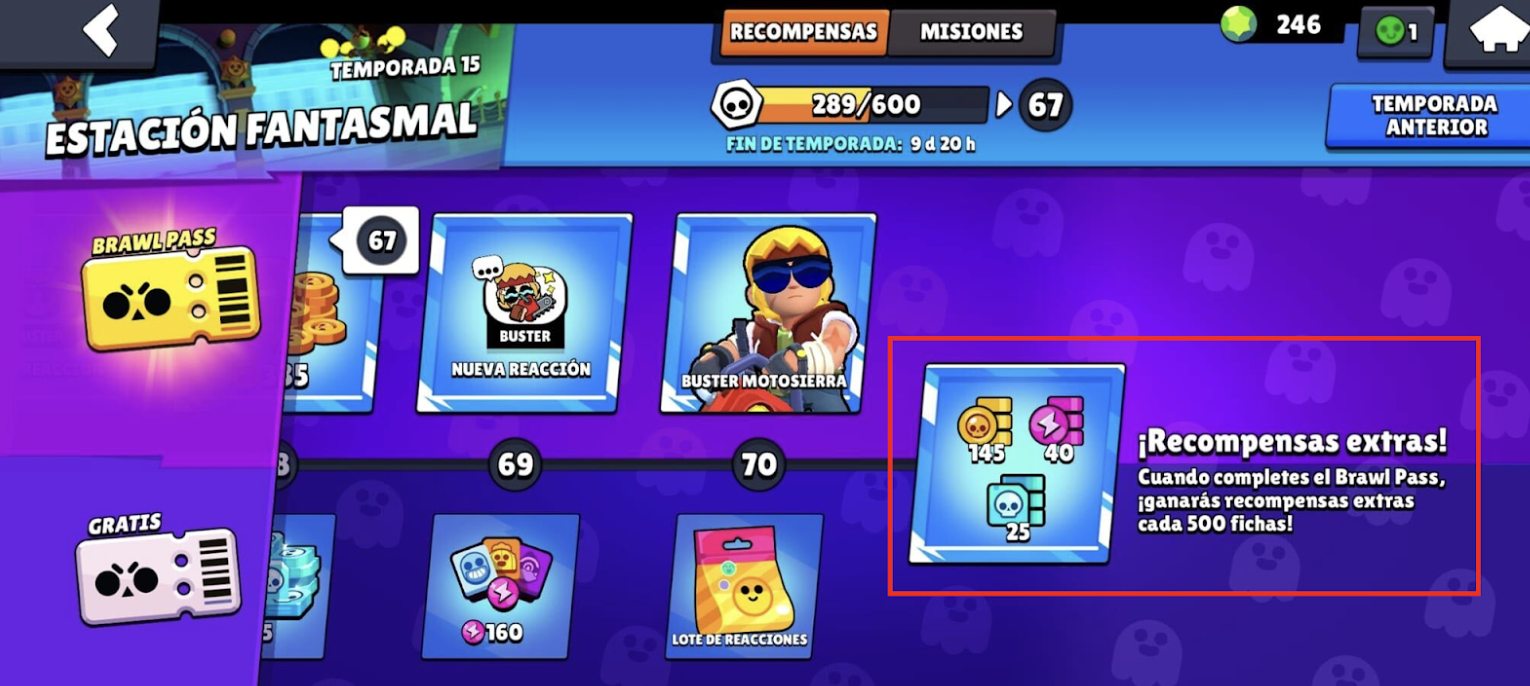Brawl Stars Ditched Loot Boxes - a Revolution or a Mistake?
On December 12th, just a few weeks ago, Supercell’s Brawl Stars shocked both their audience and the F2P devsphere by removing lootboxes.
This wasn’t a small undertaking. Brawl Boxes had been there since the release of the game, and were an integral part of its progression and monetization systems. On top of that, lootboxes are considered one of the pillars of the F2P model both by its supporters and detractors. Most importantly, this decision by a trendsetter company has implications that go beyond just Brawl Stars.
In the short term, the update has brought a significant increment in revenue. But this seems primarily linked to a big wave of downloads, many of them likely returning players attracted by the change (and possibly by re-engagement campaigns).
Since the new downloads are driven by the massive update, the flow (and its effect on the revenue) will wear off eventually. That will reveal the actual effect of the lootbox removal, but we’re not there yet.
Source: data.ai
Interestingly, there is a big difference in the results per platform. On Android, the impact has been much more positive. On iOS, the revenue has returned to normal and the RPD (revenue per download) even shows a trend that’s neutral-to-negative.
The difference can be explained by geographical differences as key Asian markets are quite Android-heavy. Another reason for Android performing better is Apple’s privacy restrictions, which have made re-engagement campaigns nearly impossible to execute.
Nevertheless, the big question here is: Will it be harder for Brawl Stars to monetize its audience when the downloads boost is gone?
While it will take months to understand the long-term consequences of the changes, I wanted to give my 2 cents now because I disagree with many opinions shared on this by other industry professionals. Several of them have dismissed this as a doomed and naïve attempt to be user-friendly, while others have implied that it has to do with recent regulations on loot boxes or with aiming to move away from dark pattern-prone mechanics (which caused a $500M fine to Fortnite - another title oriented to younger audiences).
In my humble opinion, none of the above is the main reason behind it - although there’s a point in trying to make the change as user-friendly as possible.
I believe this change aims to make Brawl Stars more effective at monetizing. And ultimately, it’s the most recent step in a direction that Brawl Stars has been moving towards in the past few years as the game has been gradually removing the impact of lootboxes in the progression. Past actions that went in this direction were, among others:
New Brawlers were available in the monthly Battle Pass, thus completely removing the need for rolling boxes to obtain them.
The Battle Pass Power Points were applicable to any brawler the player wanted, thus removing the relevance of lootboxes for upgrading (since the Pass was one of the main sources of Power Points for advanced players)
Chromatic Brawlers become easier to obtain the more time happens after its release (they start in Legendary rarity and drop to a lower rarity every new season), thus making new content progressively less scarce in lootboxes.
To justify my point on why these changes are aimed at improving monetization, I’ll explain the exact changes, why I think they did them, and give my prediction of how successful they will be and if we will see more games replicate them.
What are the changes exactly?
No more boxes are granted as a game reward, or available as a purchase. So they disappear as a mechanism to obtain coins, Brawlers, PowerPoints (character upgrade shards), etc.
New Unlock System for Brawlers. Brawlers aren’t granted in Trophy Road anymore. The new system introduces 2 new currencies to unlock characters: Credits for regular Brawlers and Chroma Credits for Chromatic Brawlers. These new currencies are obtained in different parts of the game (Pass, Trophy Road, Daily Offers…) What hasn’t changed is that still there are two new Brawlers per month: A Chromatic Brawler exclusively to the Premium Pass during the release month, and a new regular Brawler.
Direct purchase mechanisms. Players can buy any of the missing brawlers through gems. They can also pay for any missing PowerPoints. Before, players would spend these gems in Boxes, in the hope of rolling the reward they wanted.
Collection-less upgrade systems. PowerPoints (upgrade currency) now are not linked to specific characters but a generic currency that can be spent to upgrade any of the Brawlers. Additionally, the Gadgets, Star Powers, and Gears, which until now required acquiring them in Boxes (which sometimes was difficult) are now purchasable directly in credits when the Brawler reaches enough level.
Updated final rewards of the Pass. The rewards that players can grind after they complete the Pass have changed. Before they were boxes, which basically meant very little actual value. Now they’re currencies including Credits that unlocks Brawlers. I believe this is a great change as it gives more incentives to keep playing after completing the Pass.
Introduction of a new Vanity Currency (Fame). Accessible only to completionists, it’s obtained when collecting Credits after unlocking all Brawlers or exchanging excess Chroma Credits. Its only purpose right now is to be shown in the profile.
Why Brawl Stars made these changes?
I think the main reason behind this change is that the randomness-based system to acquire Brawlers had become ineffective at managing the large amounts of content that the game features now. In my opinion, the previous model was ineffective both as a monetization tool (boxes were not worth paying because they were too expensive for the little value they granted) and ineffective as a source of engagement (boxes were an unappealing reward because of their low value).
My hypothesis is that a significant number of players owned many Brawlers, but were not able to acquire the ones they missed from the loot boxes because the probabilities were very low compared to other types of rewards.
This situation was not contributing to the monetization, because these players couldn’t buy anything to get those missing Brawlers or their Power Points. It would’ve been stupidly expensive to buy an unknown amount of boxes until getting the Brawler they wanted. So the only option for players was to keep playing until the planets aligned.
And without access to their missing Brawlers, there were no extrinsic reasons for them to play the game or to buy the Pass for the Power Points. They had nowhere to spend the resources obtained because the Brawlers they owned would already be maxed out. They were also blocked from additional purchases related to these new Brawlers, like skins.
This issue is not unique to Brawl Stars. Other Supercell games (Clash of Clans, and especially Clash Royale) also have progression models that generate huge spending depth by locking valuable content under long lists of required previous acquisitions.
This approach is good to have a very controlled progression that doesn’t disrupt earlier gameplay stages with newly introduced content, and for monetizing early high-spenders that want to pay to accelerate their path to the endgame.
But over time it accumulates many users in the intermediate steps that can’t access the new playable content and the additional purchases they enable. And because randomness-based systems are not effective at enabling player progression, the progression ultimately becomes stagnant.
That is why changes to the player progression allowing them to unlock access to later elements in the progression have historically worked well in Supercell games. For example, Clash Royale recently moved the unlock of Champions earlier in the progression.
The recent changes in Brawl Stars may seem to diminish the spending depth of the game because instead of having to buy a huge amount in boxes to eventually get the Brawler you wanted, now you can get the desired ones directly with gems, at a far cheaper price.
But I think what it’s really going on is that the game is moving vertical spending depth to horizontal spending depth. The cost of the missing Brawlers now is not outrageously expensive anymore. This enables players to buy all Brawlers directly, which gives them access to other purchases such as upgrades, currencies, and skins.
The removal of loot boxes is also providing reasons to increase engagement. Now players are encouraged to play as they get to acquire resources that they can actually spend on the content they desire.
That said, this change is not without big risks, particularly because the integration, subjectively speaking, has been a bit blunt. The main risk factors I identify are:
Is it possible that the increment in horizontal spending depth doesn’t compensate for the decrease in vertical spending depth?
In particular, I’d be concerned about the loss of upgrade spending depth in newly introduced content, because although acquisition costs remain the same (new Brawlers are still obtained in the Premium Pass), maxing them out now will be way cheaper than back in the loot box era.
This could mean that new content may deplete its monetization potential faster in the new system, requiring a faster flow of new content to maintain the revenue.Is it possible that the removal of loot boxes allows spenders to progress through the content too fast? If so, the retention of advanced players may be damaged by a bigger amount of them reaching the point where they lack additional content to unlock.
Additionally, players who get all the brawlers may start to accumulate resources (Credits, Chroma Credits, Power Points…), which they can later spend to acquire instantly new content, further damaging the capacity to monetize and engage them.
But if I have to make a prediction, I think that the change will work positively in the long run.
In my opinion, it makes sense to remove loot boxes because it reinforces the value of the most valuable sources of monetization (Battle Pass, Upgrade Currencies, and Cosmetics), and takes the focus away from sources of monetization that were not that important to the revenue in Brawl Stars (Boxes) - at least in my opinion, as someone who has played the game extensively in addition to understanding a thing or two about game design.
That said, I believe the way this has been released has been very aggressive, generating more risk than needed. In my opinion, this action could’ve been derisked much better through a more progressive introduction of the changes. For example, by introducing the new progression system running in parallel with boxes.
Should other games also get rid of loot boxes?
Despite the positive results, this is still a gamble in Brawl Stars, and I would definitively not advise doing this without very careful consideration and de-risking. Factors to take into account when considering getting rid of their lootbox systems are:
How much % of the revenue do Boxes represent? The more they weight, the riskier it will be to replace them, requiring a preparation process by progressively reinforcing other sources of content and revenue.
How much is the weight of high spenders in the revenue? The collection-less approach will limit the capacity to generate high spenders and the revenue potential of new content, as it decreases the cost and friction of acquiring things and upgrading them. Instead, it puts more weight on mid and small-spenders, that have monthly ARPPUs (average revenue per paying user) that are close to the prices presented.
Is the game expanding its audience or consolidating it? Because this model focuses on moderate spenders, it won’t be effective at generating high RPD early in the funnel, which postpones the break-even moment of a newly acquired user. So it will make it hard to achieve good ROAS (return on ad spend) to fuel UA (user acquisition).
How much collection is a factor in the engagement of players? Models that allow direct access to any element in the collection destroy rarity and significantly decrease the effort and time required to access them. If obtaining rare items is an important reason why players play, this option could decrease their engagement by removing those reasons.
What incentives exist for players to want horizontal inventory diversification? The risk to avoid here is that players could just buy a few specific elements of the collection and skip the rest, thus severely decreasing the spending depth and running out of reasons to keep playing.
Does content enable access to additional goals and purchases? Otherwise, the change may not be as effective at increasing revenue and engagement, because players that acquire the content don’t increase the range of accessible products.
In the case of Brawl Stars:
I believe that Boxes were not the main source of revenue. The Battle Pass, Currencies, and Cosmetics are. So the direct revenue impact of removing Boxes was limited.
I believe the audiences skew young and thus don’t have access to big budgets. As a consequence, it’s likely that players that spend +$1000/month represent less weight in the revenue than players that spend $10-20/month. So sacrificing the tools to monetize high spenders to maximize mid-spenders makes more sense than in other games.
Brawl Stars is not a game where the main focus is scaling the audience through user acquisition. Instead, it’s a game that has already reached a big audience and is more focused on maintaining it engaged and paying every month while attracting back past players. Thus, a model that facilitates paying to get easy access to the content makes sense, it’s an approach more similar to Battle Pass-driven games like Fortnite.
Collecting rare content is not a big fun factor. What is fun in the game is playing with the Brawlers. So locking them and their upgrades (Gears, Star Powers, Gadgets…) under inefficient progression systems was locking access to the fun part for players. Removing boxes has not sacrificed any fun.
There are strong incentives to own and max out all brawlers. Among them, is the fact that the player trophies are the sum of all the individual trophies of each brawler, and that the missions of the Pass require using specific Brawlers. So there is little chance that players will just get the Brawler they love and ignore the rest forever.
Brawlers unlock additional purchases. Because once owned they need to be upgraded (meaning there are reasons to buy missing currencies and the Pass that grants them), and players can get skins for them.
Ultimately, because these conditions seem fairly specific, I’m doubtful that we will see many games take this shift away from random-drop systems towards collection-less, direct acquisition models. Even if successful, I don’t think this is an industry-shifting event.
In reality, many gameplay-oriented games that fulfill these conditions, such as League of Legends, Call of Duty Mobile, Fornite, Apex Legends, and Valorant already put the focus on Battle Pass, deterministic content unlocks, and Cosmetics, rather than on lootbox-driven progression systems.
So if anything, this could be interpreted as Brawl Stars moving toward their approach, rather than creating a new one.
I think it’s unlikely that changes in this direction ever work on games with smaller but high-spending audiences, as these games do require random-drop systems to generate high costs but maintain reasonable prices. So I think it’s unlikely that we will see changes in the same direction in 4X strategy and collection RPGs.
On games where both collection and playable content are big factors, like midcore games involving RPG mechanics or CCGs (card collecting games), I also think it’s unlikely that we will see a deprecation of random-drop systems because it will damage ARPPU since high spenders still represent an important share of the revenue.
But it is possible that they may include additional content acquisition systems and maybe rework their lootbox systems to become more efficient at providing value when spending. This is something that we see in most CCGs already, through dust systems, pity systems on the boxes, and guaranteed rarities in the booster card packs.
In any case, it will be important to take a look at this in a few months to assess the long-term impact. Whatever the final result is, kudos to the Brawl Stars team for doing a bold move when, given the performance of the game, they could afford to just not risk it.
Written by Javier Barnés. Special thanks to my friend V. Freso and all the kids from his class for the extensive feedback they gave me on the update.












